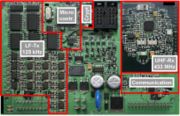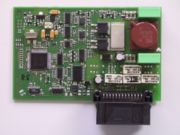
Keyless Go
Encyclopedia
Keyless Go is a generic term for an automotive technology which allows a driver to lock and unlock a vehicle without using the corresponding SmartKey buttons. Once a driver enters a vehicle with an equipped Keyless Go SmartKey or Keyless Go wallet size card, they have the ability to start and stop the engine, without inserting the SmartKey. A transponder built within the SmartKey allows the vehicle to identify a driver. An additional safety feature is integrated into the vehicle, making it impossible to lock a SmartKey with Keyless Go inside a vehicle. After a few years on the market, other luxury car manufactures have mimicked the technology, along with some economy brands. For other brand names of Keyless Entry / Go see Electronic key.
 The system works by having a series of LF (low frequency 125 kHz) transmitting antennas both inside and outside the vehicle. The external antennas are located in the door handles. When the vehicle is triggered either by pulling the handle or touching the handle an LF signal is transmitted from the antennas to the key. The key becomes activated if it is sufficiently close and it transmits its ID back to the vehicle via RF (Radio frequency >300 MHz) to a receiver located in the vehicle. If the key has the correct ID the PASE module unlocks the vehicle.
The system works by having a series of LF (low frequency 125 kHz) transmitting antennas both inside and outside the vehicle. The external antennas are located in the door handles. When the vehicle is triggered either by pulling the handle or touching the handle an LF signal is transmitted from the antennas to the key. The key becomes activated if it is sufficiently close and it transmits its ID back to the vehicle via RF (Radio frequency >300 MHz) to a receiver located in the vehicle. If the key has the correct ID the PASE module unlocks the vehicle.
The hardware blocks of a Keyless Entry / Go Electronic control unit
ECU are based on its functionality:
 A second scenario exists under the name relay station attack (RSA). The RSA is based on the idea of reducing the long physical distance between the car and the regular car owner's SmartKey. Two relay stations will be needed for this: The first relay station is located nearby the car and the second is close to the SmartKey. So on first view, the Keyless Entry / Go ECU and the SmartKey could communicate together. A third person at the car could pull the door handle and the door would open. However, in every Keyless Entry / Go system provisions exist to avoid a successful two-way communication via RSA. Some of the most known are:
A second scenario exists under the name relay station attack (RSA). The RSA is based on the idea of reducing the long physical distance between the car and the regular car owner's SmartKey. Two relay stations will be needed for this: The first relay station is located nearby the car and the second is close to the SmartKey. So on first view, the Keyless Entry / Go ECU and the SmartKey could communicate together. A third person at the car could pull the door handle and the door would open. However, in every Keyless Entry / Go system provisions exist to avoid a successful two-way communication via RSA. Some of the most known are:
Furthermore Keyless Entry / Go communicates with other ECUs. Depending on the electric car architecture there are the following systems which can be enabled or disabled:
 The system is based on a technology invented by Siemens VDO called PASE: Passive Start and Entry System. It operates in the ISM band
The system is based on a technology invented by Siemens VDO called PASE: Passive Start and Entry System. It operates in the ISM band
of radio frequencies. Keyless Entry / Go was introduced first by Mercedes-Benz
in the S-Class car series.
Overview

The hardware blocks of a Keyless Entry / Go Electronic control unit
Electronic control unit
In automotive electronics, electronic control unit is a generic term for any embedded system that controls one or more of the electrical systems or subsystems in a motor vehicle....
ECU are based on its functionality:
- transmitting low frequency LF signals via the 125 kHz power amplifier block
- receiving radio frequency RF signals (> 300 MHz) from the built-in ISMISM--ism :* -ism – a suffix, meaning adherence or following an ideology* Isms philosophical world views-ISM :ISM is an acronym of:*Idiopathic sclerosing mesenteritis*Imperial Service Medal*Incorporated Society of Musicians...
receiver block - crypting and decrypting all relevant data signals (security)
- communicating relevant interface signals with other electronic control units
- microcontroller
Inside Outside detection
The smart key determines if it is inside or outside the vehicle by measuring the strength of the LF fields. In order to start the vehicle the smart key must be inside the vehicle.System reaction times
The mark of a good passive entry system is that the user never hits the "wall". This happens when the user pulls the door handle to its full extent before the door is unlocked. This can result in the user breaking finger nails etc. The handle has to be released and pulled again to gain access. Good systems have an override feature that allows the doors to be opened more quickly.Security requirements
It is important that the vehicle can't be started when the user and therefore the smart key is outside the vehicle. This is especially important at petrol stations where the user is very close to the vehicle. The internal LF field is allowed to overshoot by a maximum of 10 cm to help minimise this risk. Maximum overshoot is usually found on the side windows where there is very little attenuation of the signal.
- measuring Group delayGroup delayGroup delay is a measure of the time delay of the amplitude envelopes of the various sinusoidal components of a signal through a device under test, and is a function of frequency for each component...
time to detect illegal high values - measuring Third-order intercept pointThird-order intercept pointIn telecommunications, a third-order intercept point is a measure for weakly nonlinear systems and devices, for example receivers, linear amplifiers and mixers. It is based on the idea that the device nonlinearity can be modeled using a low-order polynomial, derived by means of Taylor series...
to detect illegal IntermodulationIntermodulationIntermodulation or intermodulation distortion is the amplitude modulation of signals containing two or more different frequencies in a system with nonlinearities...
products - measuring Field strengthField strengthIn physics, the field strength of a field is the magnitude of its vector value.In theoretical physics, field strength is another name for the curvature form...
of the Electric fieldElectric fieldIn physics, an electric field surrounds electrically charged particles and time-varying magnetic fields. The electric field depicts the force exerted on other electrically charged objects by the electrically charged particle the field is surrounding... - measuring response time of 125 kHz LC circuitLC circuitAn LC circuit, also called a resonant circuit or tuned circuit, consists of an inductor, represented by the letter L, and a capacitor, represented by the letter C...
- using a more complex ModulationModulationIn electronics and telecommunications, modulation is the process of varying one or more properties of a high-frequency periodic waveform, called the carrier signal, with a modulating signal which typically contains information to be transmitted...
(i.e. Quadrature amplitude modulationQuadrature amplitude modulationQuadrature amplitude modulation is both an analog and a digital modulation scheme. It conveys two analog message signals, or two digital bit streams, by changing the amplitudes of two carrier waves, using the amplitude-shift keying digital modulation scheme or amplitude modulation analog...
) which can't be demodulated and modulated by a simple relay station
Furthermore Keyless Entry / Go communicates with other ECUs. Depending on the electric car architecture there are the following systems which can be enabled or disabled:
- ESCL Electric Steering Column Lock
- EIS Electronic Ignition Switch
- Central door locking system
- ImmobiliserImmobiliserAn immobiliser or immobilizer is an electronic device fitted to an automobile which prevents the engine from running unless the correct key is present...
- Engine Control UnitEngine Control UnitAn engine control unit is a type of electronic control unit that determines the amount of fuel, ignition timing and other parameters an internal combustion engine needs to keep running...
(Motor management system) - BCU Body control unit
Internal LF field dead spots
Dead spots are a result of the maximum overshoot requirement from above. The power delivered to the internal LF antennas has to be tuned to give best performance i.e. minimum dead spots and maximum average overshoot. Dead spots are usually near the extremities of the vehicle e.g. the rear parcel shelf.Backup in case of low battery
If the battery in the Smart key becomes worn out it is necessary for there to be a backup method of opening and starting the vehicle. Opening is achieved by an emergency key blade usually hidden in the Smart key. Starting is achieved by a transponder inside the Smart key that does not need batteries to work. The user either has to put the key in a slot or hold it near a special area on the cockpit, where there is another LF antenna (transponder coil) hidden behind. Slots have proven to be problematic as they can go wrong and the key becomes locked in and can't be removed.Special Cases
A Keyless Entry / Go system should be able to detect and handle most of the following cases:- SmartKey Transponder was forgotten in the rear trunk
- more than one SmartKeys are inside the car
- SmartKey get lost during drive
- Smartkey battery low (Limp-Home)
History

ISM band
The industrial, scientific and medical radio bands are radio bands reserved internationally for the use of radio frequency energy for industrial, scientific and medical purposes other than communications....
of radio frequencies. Keyless Entry / Go was introduced first by Mercedes-Benz
Mercedes-Benz
Mercedes-Benz is a German manufacturer of automobiles, buses, coaches, and trucks. Mercedes-Benz is a division of its parent company, Daimler AG...
in the S-Class car series.
Outlook
Today a Keyless Entry / Go system is a state-of-the art technology and it has a lot of potential to optimise. Here are some general trends of the advance (AD) and series development (SD):- SD: reduction of used LF antennas in low cost compact cars (results in a loss of detection quality)
- AD: using electric field antennas instead of magnetic field antennas (cost reduction)
- AD: using microwave frequencies (radar) instead of an LF and RF combination (more comfort)
- AD: Biometric authenticationAuthenticationAuthentication is the act of confirming the truth of an attribute of a datum or entity...
would identify the user and not the SmartKey transponder
External links
- Article about how keyless entry remote systems on automobiles work
- Requirements of Remote Keyless Entry (RKE) Systems
- Designing Remote Keyless Entry (RKE) Systems
- Example of an aftermarket smart key systems
- Relay Attacks on Passive Keyless Entry and Start Systems in Modern Cars
Literature
- Schmitz/Roser (Bosch): A New State-of-the-Art Keyless Entry System. SAE-Papers, Stuttgart 1998, SAE 980381.
- Schmitz/Kruppa/Crowhurst (Bosch): Safety and Security Considerations of New Closure Systems. SAE-Papers, Wuppertal/Stuttgart/Clayton (AUS) 2000, SAE 2000-01-1304.

